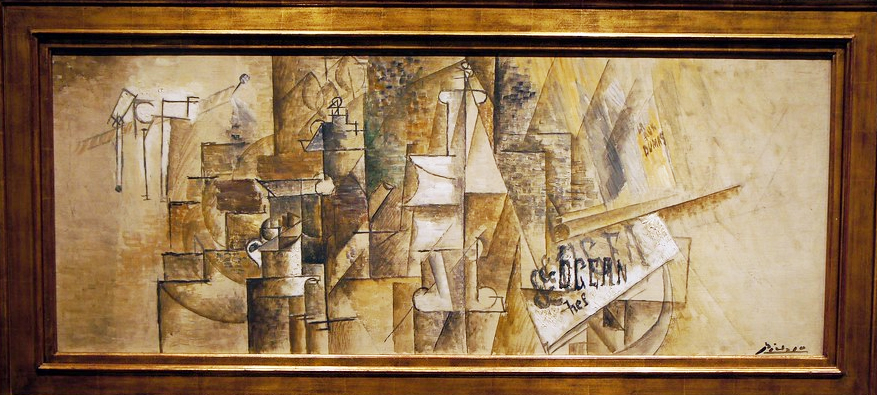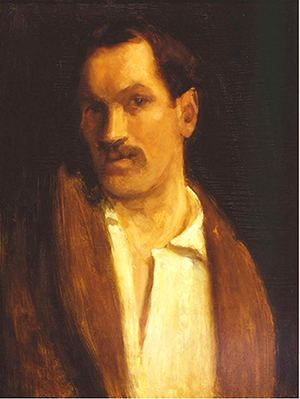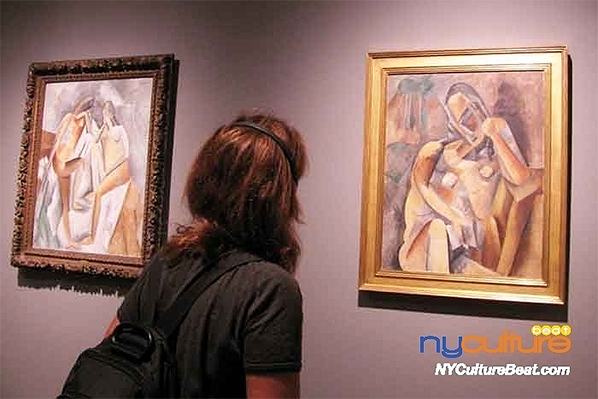피카소의 브루클린 주택 커미션 작품전@메트뮤지엄(9/14-1/14, 2024)
Picasso: A Cubist Commission in Brooklyn
아티스트/비평가 해밀턴 이스트 필드 서재 패널
메트뮤지엄 브루클린하이츠 주택 커미션 특별전

Pablo Picasso, Pipe Rack and Still Life on a Table, Oil and charcoal on canvas, 19 1/2 × 50 in., 1911, The Metropolitan Museum of Art collection
앙리 마티스(Henri Matisse, 1869-1954)는 미국에 왔었지만, 파블로 피카소(1881-1973)는 생전에 미국을 한번도 방문한 적이 없다. 하지만, 1910년 시기에 아티스트이자 비평가이며 컬렉터였던 해밀턴 이스트 필드(Hamilton East Field, 1873-1922)의 브루클린하이츠의 타운하우스 (110 Columbia Heights)을 위한 장식 작업을 했다.
이 작업이 실현되지는 않았지만, 피카소가 큐비즘을 탐구하는 계기가 됐다. 메트로폴리탄뮤지엄은 브루클린 커미션과 관련된 회화 6점과 드로잉을 소개하는 특별전 'Picasso: A Cubist Commission in Brooklyn'을 연다.
1909년 해밀턴 이스트 필드는 유럽에서 필드의 사촌 프랭크 버티 하빌란드의 소개로 피카소를 만났다. 필드는 피카소에게 자신의 브루클린 하이츠 주택의 서재를 장식할 그림 11점을 의뢰했다. 피카소는 1915년까지 최소한 8개의 패널을 완성했지만, 후에 프로젝트를 포기했다. 이중 한 점인 입체파 회화 '파이프 랙과 식탁 위의 정물(Pipe Rack and Still Life on a Table)'는 현재 메트로폴리탄 뮤지엄이 소장하고 있다. 이 그림의 오른쪽 상단엔 알렉산더 뒤마 피스의 소설 '동백꽃 아가씨(La Dame aux Camélias, 1848-*오페라 '라 트라비아타(춘희)'의 원작)'을 언급했으며, 하단엔 필드의 이니셜 HEF가 박혀있다. 필드의 커미션이 완성됐다면, 미국 최초의 입체파 장식 인테리어가 됐을 것이다.

Hamilton Easter Field, Self Portrait, about 1898, oil on panel, 12 in. x 18 in., Portland Museum of Art
해밀턴 이스트 필드는 화가 우드 게일러에 따르면, "100년에 한번 나올까말까한 인물로 화가/비평가/교사/편집자로서 미국 미술에 지대한 영향을 끼친 천재"였다. 특히 일본 판화에 관한한 당대의 권위자였다.
1873년 뉴저지 어빙턴의 부유한 가문에서 태어난 해밀턴 이스터 필드는 브루클린프렌즈스쿨, 브루클린폴리테크닉을 거쳐 컬럼비아대에서 공학과 화학을 전공했다. 1894년 컬럼비아대 중퇴 후 하버드대로 전학했다가 파리로 이주해 화가 장-레옹 제롬, 알이 팡탕-라투르 등 아래서 미술 공부를 했다.
풍경화에 집중했던 필드는 1915년 맨해튼 5애브뉴의 윌리엄글로센갤러리에서 개인전을 열었다. 1912년엔 브루클린하이츠 자택 옆에 갤러리(Ardsley House)를 오픈했었으며, 브루클린 이글(Brooklyn Eagle) 신문의 비평가로도 활동했다. 프랑스 조각가 로베르 로랑(Robert Laurent) 등 젊은 작가들을 후원했다.

Cubism: The Leonard A. Lauder Collection, 2014, The Metropolitan Museum of Art
이 전시는 레너드 A. 라우더의 현대미술연구센터의 연구 시리즈중 두번째 전시이자 피카소의 사망 50주기를 기념하는 국제 행사 'Celebration Picasso 1973-2023'의 일환이다.
2013년 4월 레오나드 A. 로더(Leonard A. Lauder) 에스테로더 명예회장은 메트뮤지엄에 자신의 입체파(큐비즘, Cubism) 컬렉션 78점을 기증하기로 약정했으며, 이후 3점을 더 구입해 81점을 기증했다. 메트뮤지엄은 2014년 10월부터 2015년 2월까지 'Cubism: The Leonard A. Lauder Collection'전을 열었다.
*메트뮤지엄 레오나드 로더 입체파 4인방 컬렉션 특별전, 2014
https://www.nyculturebeat.com/index.php?mid=Art2&document_srl=3168339
Picasso: A Cubist Commission in Brooklyn
September 14, 2023–January 14, 2024
The Met Fifth Avenue Gallery 830
On September 14, 2023, The Met will open Picasso: A Cubist Commission in Brooklyn, the first exhibition dedicated to a captivating, but lesser-known chapter in the Cubist period of Pablo Picasso (1881–1973). In 1910, while making radical formal experiments with the human figure that brought him to the brink of abstraction, the artist embarked on a decorative commission for the Brooklyn residence of artist, collector, and critic Hamilton Easter Field (1873–1922). While the commission ultimately went unrealized, it served as a catalyst for Picasso’s exploration of Cubism, as he worked, abandoned, and reworked the panels in various studios in France. This focused exhibition will bring together for the first time six paintings linked to the commission—a group of figure and still life compositions—along with related works and archival material. It provides a unique opportunity to view these canvases together in the same gallery and to consider them in relation to the architectural space for which they were originally intended.
Picasso: A Cubist Commission in Brooklyn and the accompanying publication are made possible by the Leonard A. Lauder Research Center for Modern Art.
Picasso and Field met in Paris through a mutual friend in fall 1909, an encounter that prompted Field to offer the 28-year-old Spaniard a room in his Brooklyn Heights home—the library—to adorn with murals. The commission presented Picasso his first opportunity to move beyond easel painting and apply his radical Cubist style to decorative painting formats of challenging size and proportion. According to artist Robert Laurent (1890–1970), the elated Picasso proclaimed that “it was just the sort of commission he had been hoping for.” In August the following year, Picasso received Field’s formal brief with exact details of the long and narrow room—approximately 10 x 23 feet—in which up to 11 panels were to be installed, as well as a guarantee of artistic autonomy: “I give you compete freedom,” Field declared. In 1919, a decade after meeting Picasso in Paris, Field wrote about that encounter in one of his regular art columns for his hometown newspaper the Brooklyn Daily Eagle, remarking that the decorations were not yet finished. Field died two years later at age 49 never having seen any of Picasso’s panels for his home library. The Field residence was demolished around 1947.
No painting by Picasso was ever linked to the commission during the artist’s lifetime. Only the discovery of Field’s sole 1910 letter preserved in Picasso’s personal archives some 15 years after the artist’s death allowed Picasso experts to reassess some of his unusually sized and proportioned Cubist paintings. A comparison with the dimensions of the room’s individual wall areas outlined in Field’s letter yielded several exact or near-exact matches, prompting in turn speculations as to how far Picasso took the project and why it remained unrealized. Field’s seemingly hands-off approach and Picasso’s difficulty in maintaining formal unity across various formats—some unusually large and others unusually narrow—were put forth as the likely impediments.
With new research on Field, Picasso, and the proposed installation site, Picasso: A Cubist Commission in Brooklyn will expand beyond the initial art historical accounts of the commission and consider closely how the artist proceeded to engage with the challenge of creating a decorative ensemble. The exhibition will unfold across Gallery 830 in four parts. The core will be devoted to six paintings associated with the commission itself. Included will be two of Picasso’s abstract Cubist figurative works of 1910—the narrow, nearly six-foot tall Nude Woman from the National Gallery of Art, Washington, D.C. and the even more enigmatic Reclining Woman on a Sofa, a loan from a private collection. The latter represents a rare subject for Picasso’s Cubism. Oblong and horizontal, it was also the first of three overdoor panels Picasso created for the Field library. Two equally-sized still lifes identified as the commission’s remaining two overdoors, begun in summer 1911 in Céret—The Met’s own Pipe Rack and Still Life on a Table and Still Life on a Piano, a loan from the Museum Berggruen—will be installed side by side for the first time. The section will also present two canvases generously lent by the Musée national Picasso-Paris, Man with a Guitar and Man with a Mandolin. The artist enlarged both with canvas added along the bottom edge, nearly doubling their length. These two imposing paintings attest to a shift in interest in the size and proportion for Cubist compositions.
The exhibition then focuses on Field and his Brooklyn residence, featuring Field’s 1910 commissioning letter, the key textual evidence of the project. Illustrated with Field’s renderings of a wall elevation and the plan of the room allocated to Picasso, it will allow visitors to gain a sense of the architectural site. Furthering this objective is the inclusion of a decorative wooden panel executed by Laurent in 1913 for the Field residence that features floors plans of the house, including its parlor level where the library was located.
While no designs or sketches for the commission have been identified in Picasso’s vast Cubist oeuvre to date, through a group of figurative works dated to 1910—all centered on a vertical female nude—the exhibition will bring into focus the period when Picasso began working on the commission. Among the selection are three pen-and-ink drawings from the summer of 1910, including one from the Leonard A. Lauder Cubist Collection, now part of The Met’s holdings, as well as a unique oil sketch on loan from the Fundación Almine y Bernard Ruiz-Picasso para el Arte.
The exhibition concludes by contextualizing the Field commission within Picasso’s wider presence in New York in the early decades of the 20th century, namely the artist’s first exhibition in the United States at Alfred Stieglitz’s gallery 291 in spring 1911. It will feature the only two drawings sold at this landmark event, both representing a female figure: the large 1910 charcoal Cubist drawing acquired by Stieglitz, now in The Met collection, as well as a 1905–06 pen-and-ink sheet purchased by Field, a loan from the Museum of Fine Arts, Boston.
Credits and Related Information
The exhibition is organized by Anna Jozefacka, guest curator, with Lauren Rosati, Assistant Curator in the Department of Modern and Contemporary Art and the Leonard A. Lauder Research Center for Modern Art at The Met.
It is accompanied by a fully illustrated catalogue with a chronology of the commission and an essay by Jozefacka that situates the Field commission within the rich European decorative painting tradition, offering thus far unconsidered points of reference for Picasso’s Cubism.
Picasso: A Cubist Commission in Brooklyn is the second in a series of focused research exhibitions under the auspices of the Leonard A. Lauder Research Center for Modern Art.
The Met is grateful to the many lenders for their exceptional generosity, with special acknowledgment to the Musée National Picasso-Paris.
This exhibition is a participant in the international Celebration Picasso 1973–2023, which marks the 50th anniversary of the artist’s death.




 구겐하임 뮤지엄 '젊은 그들: 한국 실험미술 1960-70년대'전 #Exp...
구겐하임 뮤지엄 '젊은 그들: 한국 실험미술 1960-70년대'전 #Exp...
 사진의 친밀성과 욕망에 관하여 'Love Songs: Photography and In...
사진의 친밀성과 욕망에 관하여 'Love Songs: Photography and In...


브루클린하이츠 주택 서재를 위해 그린 그림을 보니까 아무도 범접할 수없는 피카소만이 작품을 만들어내는 초능력이 번뜩였습니다. 서재 벽이 점점 나에게 다가오고, 서재가 몽땅 튀어나와서 어떤 구실을 하는게 아닌가 하는 현실감을 느꼈습니다. 입체파 그림의 힘이 이렇게 크구나를 실감했습니다. 그림을 보면 볼수록 자꾸 앞으로 다가오네요.
-Elaine-